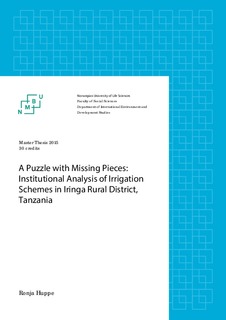| dc.description.abstract | Irrigation management has been internationally discussed and shapes national water policies, also in Tanzania. Yet, farmers in Iringa Rural district still suffer from too dry or flooded fields, while officials are blamed for failing to implement the water policy. Thus, to better understand what accounts for this gap between national regulations of irrigation and local irrigation practices, this study investigated the formalization process of the irrigation institutions from basin to village level and farmers’ livelihoods and dependence on irrigation. Mixed methods were used; institutional characteristics of a traditional (TS) and semi-improved scheme (IS) were analysed and compared from a mainstream and critical institutionalist perspective, farmers’ livelihoods with help of the sustainable livelihoods approach (SLA) (Ellis 2000a).
The findings suggest that communal irrigation management works; yet, the institutions resembled a bricolage rather than a fixed set of rules (Cleaver 2012; Ostrom 1990). The IS had a higher level of formalization than the TS, but water use-rules were informal and often unfair. The amount of allocated water and the area schemes serve is similar, yet, the IS is used by seven villages, while the TS only by two villages. SLA showed that farmers in the TS owned four times more land and had higher net-incomes than farmers in the IS. In both schemes, farmers highly depended on irrigation: 70% of their main income share came from irrigated paddies, yet, from input-extensive production. Thus, irrigated paddies have high investment potential; but high irrigation dependency and low crop diversity also comes with a high economic risk and may increase farmers’ economic vulnerability. Further, a lack of water-allocation criteria on basin level facilitated the prioritization of hydropower over irrigation. Thus, farmers only have water access during the rainy season. Thus, formalization of schemes may lead to increased control over small-scale farmers and less resource access. Hence, farmers may face threat of resource appropriation by the state.
Thus, this study recommends further investigation of the basin-wide water re-allocation between different water sectors in general, and within the economic sector and between small-scale and large-scale users in particular. Moreover, Tanzania needs to define clearer criteria for and stricter monitoring of water allocation while leaving room for more community driven local irrigation management within schemes. | nb_NO |

